
CHAPTER 25 Web
The Economics of Developing Countries
Note: This bonus web chapter is available at the textbook Web site: www.mcconnell20e.com.
A. Short-Answer, Essays, and Problems
2. How are countries classified based on income?
3. What is the magnitude of the differences in GDP per capita between industrially advanced countries and
developing countries?
4. Assume real per capita income in an industrially advanced country is $37,665 per year and $523 per year in
a low-income developing country.
5. In terms of economic and social conditions, how do industrially advanced countries and developing
countries differ?
7. A breakdown of the shares of economic production for two different countries is listed below, along with
per capita income and growth rate. Use this information to calculate the growth rates per sector and answer
the following questions.
Country A
Country B
Growth
Rates A
Growth
Rates B
Services
10%
60%
____
____
Industry
15%
20%
____
____
Natural Resources
30%
15%
____
____
Agricultural
45%
5%
____
____
Per Capita Growth Rate
5%
5%
---
---
Per Capita Income
$400
$25,000
---
---
(a) What is the amount of per capita growth in countries A and B? Will the growth increase, decrease or
maintain the income gap?
(b) Suppose country A’s economy becomes more industrialized, increasing the productive share of
services and industry. What likely effect will this having on country A’s growth rate? Suppose as a
result of this change the growth rate of services and industry is now 3.5% and 2.5% respectively, while
the rates for natural resources and agriculture remain the same. What is the new total growth rate?
What is the new distribution of the economy? What is the effect of the new growth on the income
gap?
(c) What growth rate would country A have to maintain to reduce the income gap with country B by 10%,
assuming country B grew by 5%? If country B grew by 2%? If country B experienced no growth?
(d) What growth rate would country A have to maintain to reduce the income gap with country B
completely if country B experienced 3% growth?

8. What are the human realities of poverty in DVCs?
9. It is stated that “the avenues of economic growth are essentially the same for both industrially advanced
and developing nations.” What are the two basic avenues?
10. What is the natural resource problem in DVCs?
11. Evaluate the statement: “No nation can grow without a large natural resource base.”
12. List the three major human resource problems in developing nations.
13. What is the human resource problem in DVCs?
14. Discuss the problem of population in developing nations using the rule of 70.
15. Why might income gains in the poorest DVCs increase population growth, at least for a while?
16. Explain the logic behind the demographic transition view.
17. Why do developing nations often have low labor productivity? Are the workers just lazy?
18. What is the capital accumulation problem in DVCs?
19. Economic development in DVCs often focuses on capital accumulation. Why?
20. What are the prospects for domestic capital formation in DVCs?
21. What is the technology problem in DVCs?
22. What is the difference between capital-using and capital-saving technological advances? Give examples.
23. Of what significance is the “will to develop”?
24. Why is land reform of significant concern for developing countries and what restricts its implementation?
25. Compare the problems in achieving growth in an advanced nation with those of a developing nation. Do
these problems differ in degree or in kind? Explain.
26. Draw and explain a diagram that illustrates the vicious circle of poverty in DVCs.

27. What positive role can government play in fostering economic growth in developing countries?
28. How can embracing globalization by governments in DVCs promote economic growth?
29. What are the problems with government actions in DVCs?
30. What can IACs do to expand trade with DVCs?
32. If IACs admit more temporary workers from DVCs, will it help DVCs? Explain.
33. Describe the main characteristics of direct foreign aid from IACs to DVCs.
34. Discuss the allocation of direct foreign aid from IACs to the lowest-income DVCs and its issues.
35. How can debt policies for DVCs create a moral hazard?
36. What is the World Bank? Explain its primary purpose.
37. What are two affiliates of the World Bank? What do they do?
38. What are the three basic criticisms of foreign aid to DVCs?
39. Describe the characteristics of private capital flows to DVCs.
40. (Last Word) What are the roots of the persistent famines in sub-Saharan Africa?
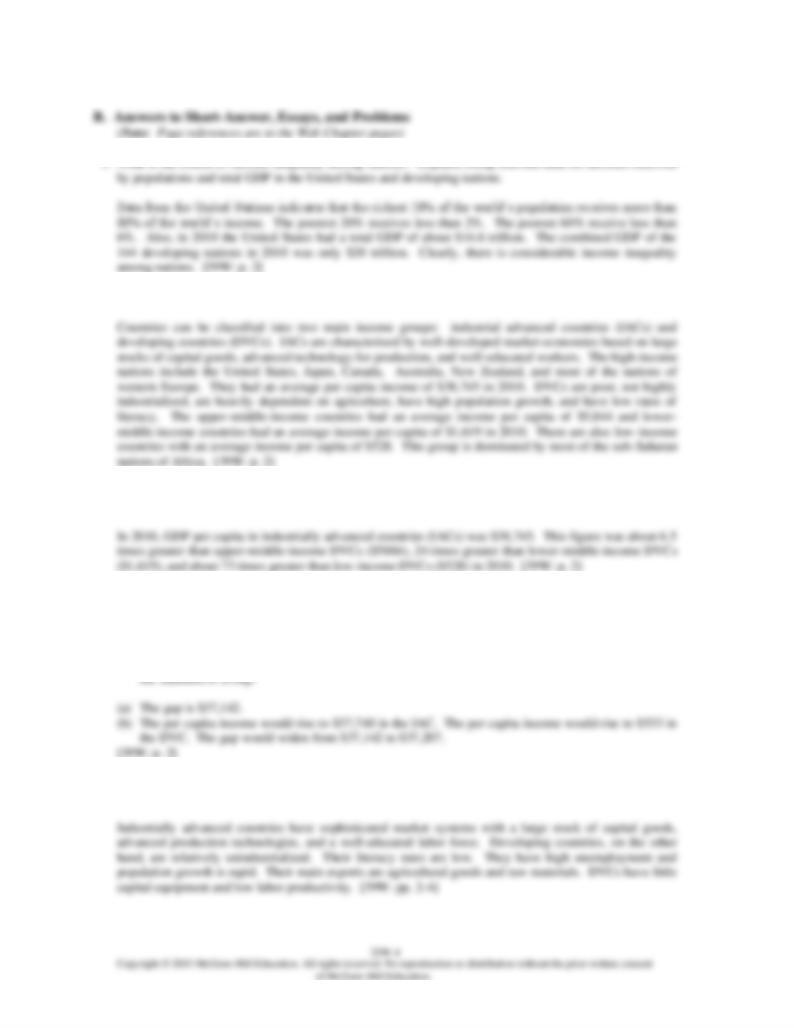
2. How are countries classified based on income?
3. What is the magnitude of the differences in GDP per capita between industrially advanced countries and
developing countries?
4. Assume real per capita income in an industrially advanced country is $37,665 per year and $523 per year in
a low-income developing country.
(a) What is the gap in the standards of living?
(b) If real per capita income were to grow at a rate of 2% during a year in both the industrially advanced
and the developing country, what would happen to the standard of living in each country and the gap in
5. In terms of economic and social conditions, how do industrially advanced countries and developing
countries differ?

6. “If two countries are growing at the same rate, the income gap between the two countries should remain the
same.” Evaluate this statement.
This statement is incorrect. In the case of a low income country (earning say, $300 per capita per year) and
a high income country (earning $30,000 per capita per year), a growth rate of 5% in each country produces
a very different income growth. At the start, the income gap is $29,700. Growing at 5%, the low income
country earns $15 and the high income country earns $1500. Average yearly per capita incomes now total
7. A breakdown of the shares of economic production for two different countries is listed below, along with
per capita income and growth rate. Use this information to calculate the growth rates per sector and answer
the following questions.
Country A
Country B
Growth
Rates A
Growth
Rates B
Services
10%
60%
____
____
Industry
15%
20%
____
____
Natural Resources
30%
15%
____
____
Agricultural
45%
5%
____
____
Per Capita Growth Rate
5%
5%
---
---
Per Capita Income
$400
$25,000
---
---
(a) What is the amount of per capita growth in countries A and B? Will the growth increase, decrease or
maintain the income gap?
(b) Suppose country A’s economy becomes more industrialized, increasing the productive share of
services and industry. What likely effect will this having on country A’s growth rate? Suppose as a
result of this change the growth rate of services and industry is now 3.5% and 2.5% respectively, while
the rates for natural resources and agriculture remain the same. What is the new total growth rate?
What is the new distribution of the economy? What is the effect of the new growth on the income
gap?
(c) What growth rate would country A have to maintain to reduce the income gap with country B by 10%,
assuming country B grew by 5%? If country B grew by 2%? If country B experienced no growth?
(d) What growth rate would country A have to maintain to reduce the income gap with country B
Services
10%
60%
0.50%
3.00%
Industry
15%
20%
0.75
1.00
Natural Resources
30%
15%
1.50
0.75
Agricultural
45%
5%
2.25
0.75
Per Capita Growth Rate
5%
5%
---
---
Per Capita Income
$400
$25,000
---
---
(a) The per capita growth in country A is $20 and the per capita growth in country B is $1250. The
growth will increase the absolute income gap by $1230 from $24,600 to $25,830.
(b) The industrial shift will likely increase country A’s growth rate, as its economy shifts to more
productive and technologically advanced sectors and away from less efficient sectors of natural
resources and agriculture that have more volatile prices. The new growth rate is 9.75%. The
breakdown of the economy is now approximately 36% services, 26%, industry, 15% natural resources
and 23% agriculture. The income gap will still increase, but only by $1211 compared to $1230.
(c) Country A would have to grow by 656.25% to reduce the income gap with country B by 10% if they
grew by 5%. If country B only grew by 2%, country A would still have to grow by 637.5% to reduce
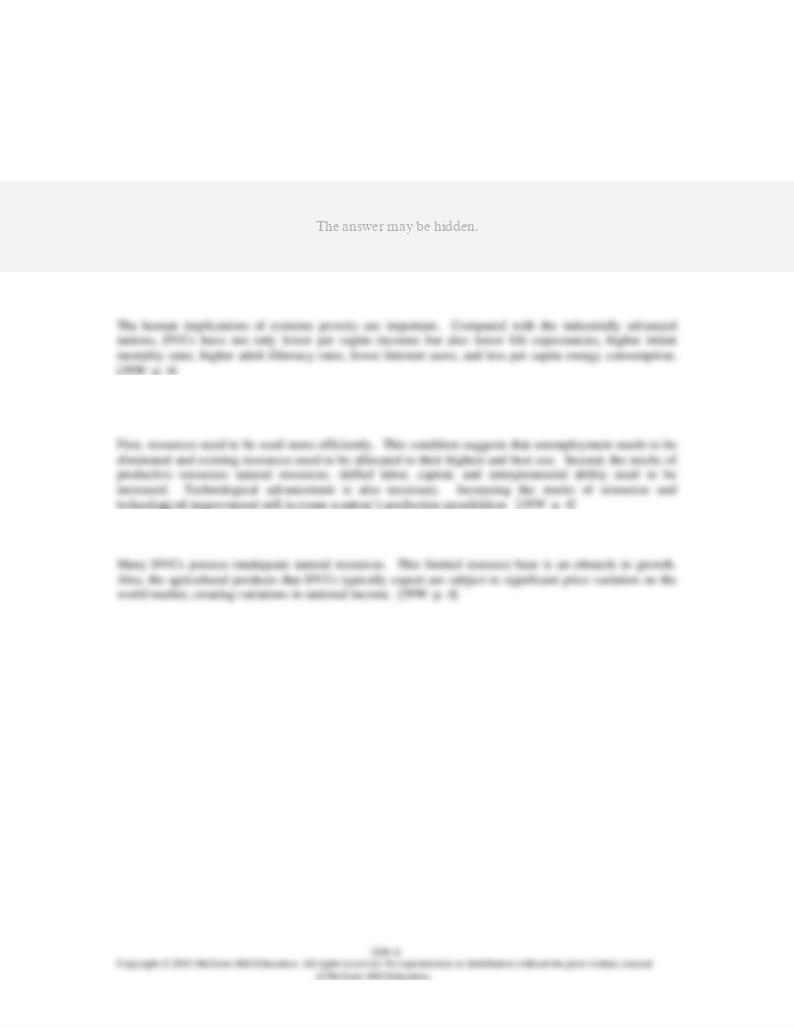
the income gap by 10%. If country B experienced no growth, country A would have to grow by 625%
to reduce the income gap by 10%.
(d) Country A would have to grow by 6437.5% to completely remove the income gap.
(e) The results of (a) through (d) show that developing countries face a significant climb in growth to
catch up with industrially advanced countries, even if they want to make a small improvement in the
8. What are the human realities of poverty in DVCs?
9. It is stated that “the avenues of economic growth are essentially the same for both industrially advanced
and developing nations.” What are the two basic avenues?
10. What is the natural resource problem in DVCs?
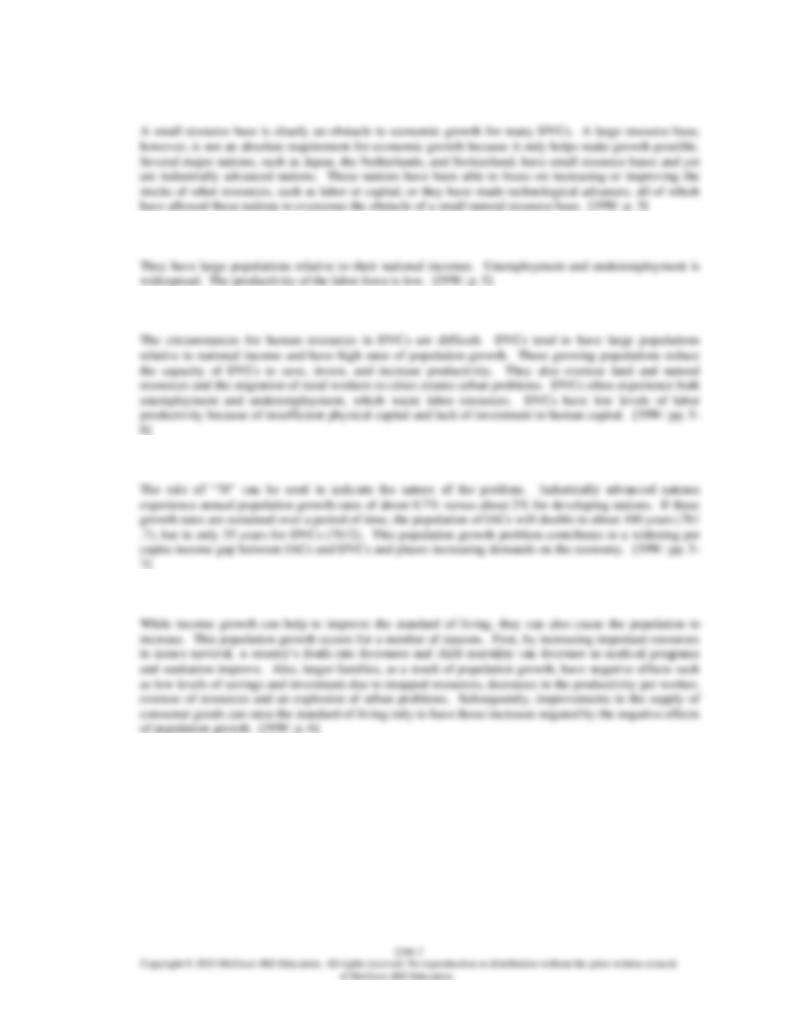
11. Evaluate the statement: “No nation can grow without a large natural resource base.”
12. List the three major human resource problems in developing nations.
13. What is the human resource problem in DVCs?
14. Discuss the problem of population in developing nations using the rule of 70.
15. Why might income gains in the poorest DVCs increase population growth, at least for a while?
16. Explain the logic behind the demographic transition view.
In a demographic transition population growth will be controlled as incomes increase in a country. The
argument is founded in the idea that as income increases, the marginal benefit of having additional children
decreases. Thus population growth will slow as having large families becomes less and less attractive and
economically necessary. The growing disincentive comes from the fact that in wealthier countries the cost
of raising children increases as they require higher and higher costs of childcare, education and other
investments. Also, the marginal benefits of having additional children decreases as children become less
necessary for insuring care in old age. Thus from a demographic transition perspective population control
is a step in producing improved incomes but that population control will follow income growth. [39W: p.
7]
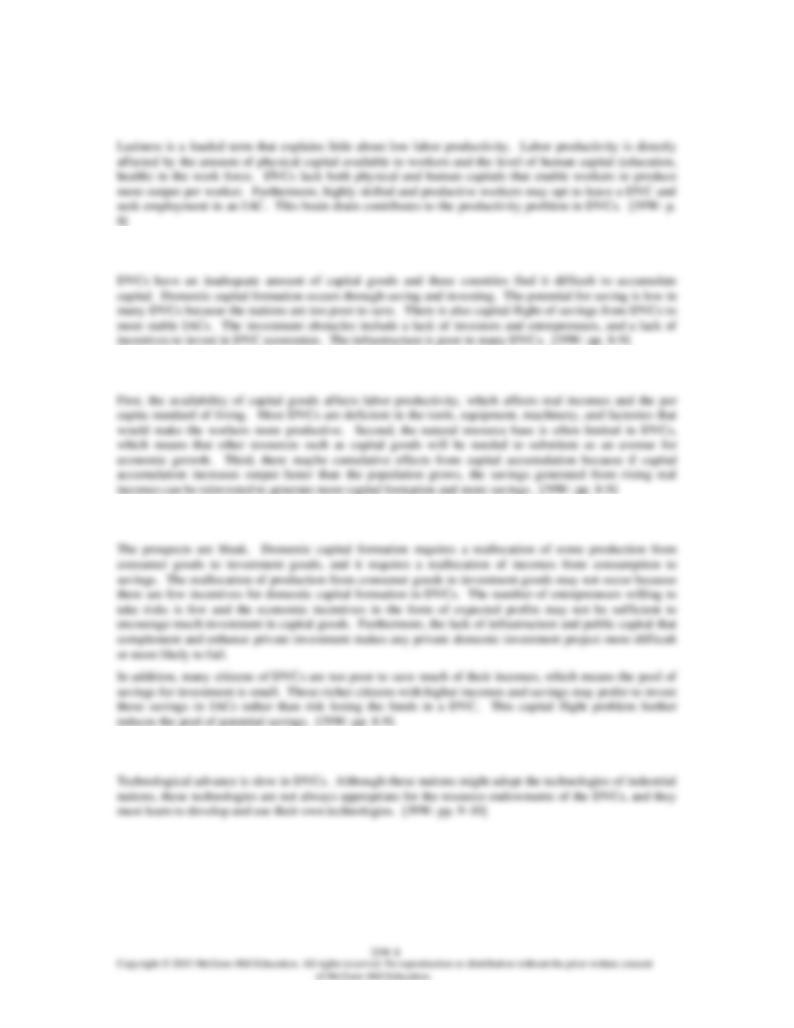
17. Why do developing nations often have low labor productivity? Are the workers just lazy?
18. What is the capital accumulation problem in DVCs?
19. Economic development in DVCs often focuses on capital accumulation. Why?
20. What are the prospects for domestic capital formation in DVCs?
21. What is the technology problem in DVCs?
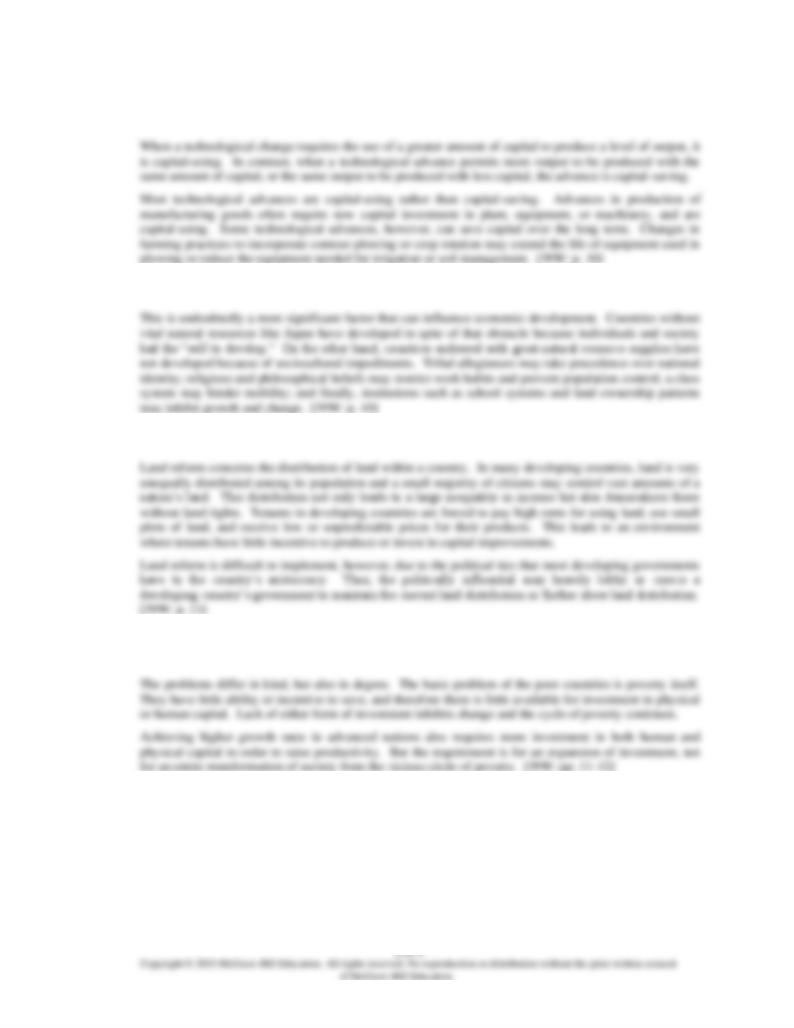
22. What is the difference between capital-using and capital-saving technological advances? Give examples.
23. Of what significance is the “will to develop”?
24. Why is land reform of significant concern for developing countries and what restricts its implementation?
25. Compare the problems in achieving growth in an advanced nation with those of a developing nation. Do
these problems differ in degree or in kind? Explain.
26. Draw and explain a diagram that illustrates the vicious circle of poverty in DVCs.

27. What positive role can government play in fostering economic growth in developing countries?
28. How can embracing globalization by governments in DVCs promote economic growth?
29. What are the problems with government actions in DVCs?
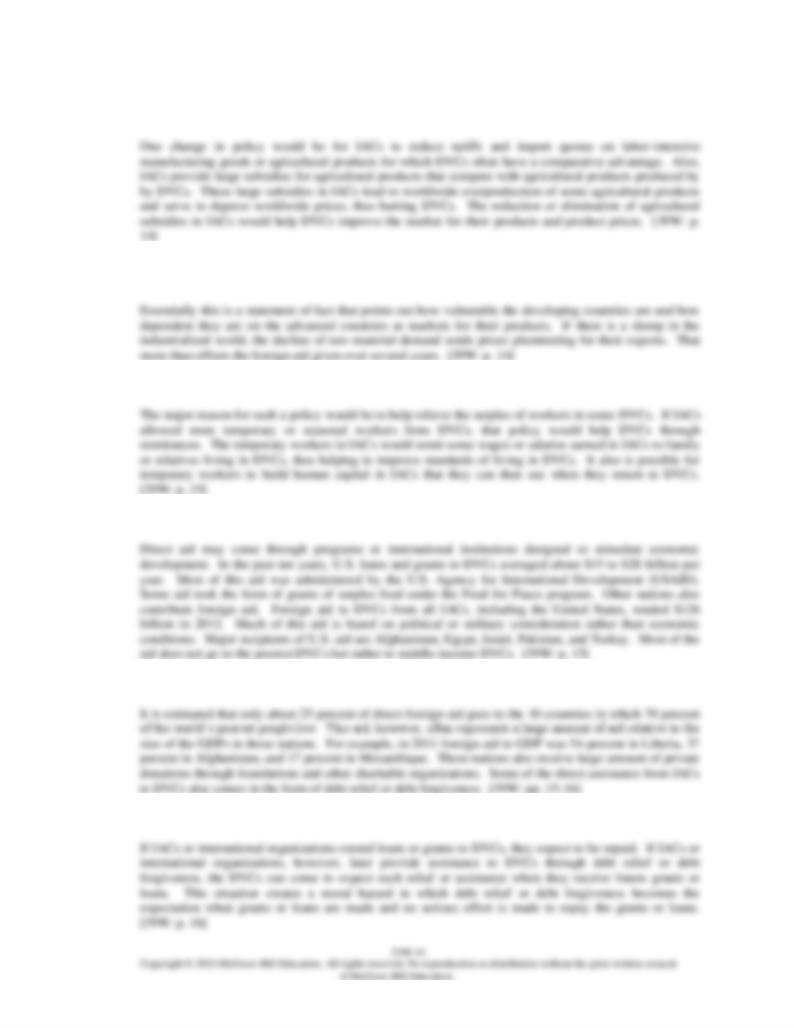
30. What can IACs do to expand trade with DVCs?
31. “In a recent recession the losses sustained by the developing countries through a decline in raw -material
prices by far outweighed any foreign aid given over several years.” Explain.
32. If IACs admit more temporary workers from DVCs, will it help DVCs? Explain.
33. Describe the main characteristics of direct foreign aid from IACs to DVCs.
34. Discuss the allocation of direct foreign aid from IACs to the lowest-income DVCs and its issues.
35. How can debt policies for DVCs create a moral hazard?
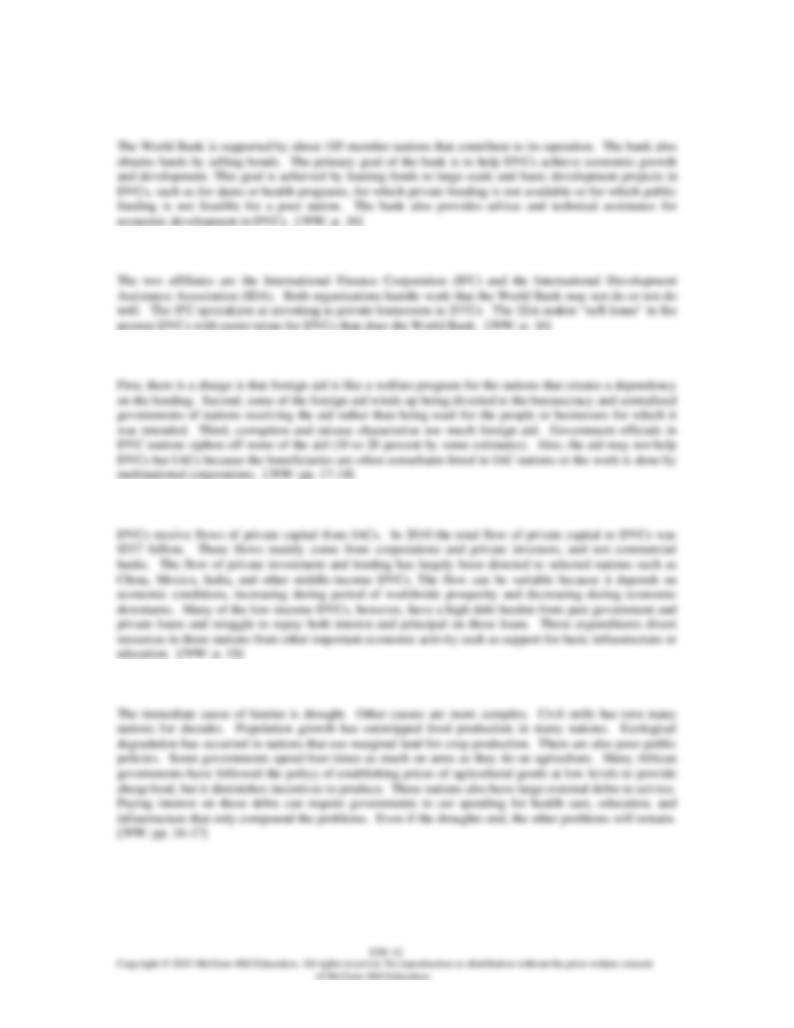
36. What is the World Bank? Explain its primary purpose.
37. What are two affiliates of the World Bank? What do they do?
38. What are the three basic criticisms of foreign aid to DVCs?
39. Describe the characteristics of private capital flows to DVCs.
40. (Last Word) What are the roots of the persistent famines in sub-Saharan Africa?